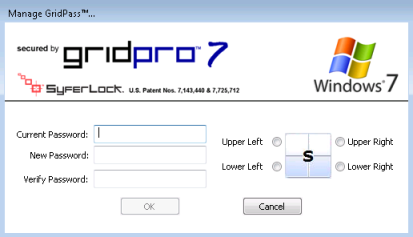
SyferLock’s GridPro™ authentication solution is used to secure access to Windows based laptops, desktops and servers.
The GridPro™ authentication solution consists of a log-in application (replacing the standard Windows log-in) that presents the user with a software-based grid for secure, multi-factor authentication.
The first time the user accesses the system (or any time the user changes their password), they will be prompted to pick a target corner along with the password. On subsequent log-ins, the user will, using SyferLock’s one-time password methodology, input the numbers corresponding to their pre-selected corner position in place of associated static password characters as their one-time password.
On Windows XP, GridPro™ is deployed as a GINA replacement. On Windows 7, 8 and 10, GridPro™ is deployed as a Credential Provider.
Try GridPro™ At No Charge or Obligation
- If you are interested in trying out GridPro™ with a proof of concept at no charge or obligation, please contact sales.
Platform Support
32-bit & 64-bit architectures are supported on all operating systems
- Windows XP, 2000, Vista, 7, 8 and 10
- Windows Server 2003, 2008
Case Study
Key Differentiating Factors
-
Strengthens Existing Password
GridPro™ is based on user's Active Directory password; it simply strengthens the password without requiring hard tokens or supplemental PINs. -
Protection Against Attack Vectors
Using SyferLock's patented methodology, the user enters their one-time-password known as the GridCode™ instead of their static network password. By eliminating the need to enter the user's static Active Directory password, GridPro™ provides protection against attack vectors like key loggers and shoulder surfers. -
No Connectivity Required
GridPro™ does not require any connectivity for the log-in to succeed. In offline mode, the user is authenticated against cached credentials. -
Console & RDP Access
GridPro™ protects the machine both via native console access and RDP access. -
Multi-User Support
With GridPro™ multiple users can log-on to the same machine each with their own credentials.
